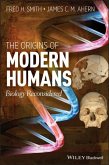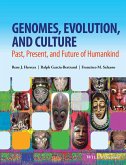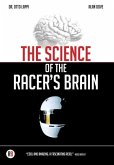- Gebundenes Buch
- Merkliste
- Auf die Merkliste
- Bewerten Bewerten
- Teilen
- Produkt teilen
- Produkterinnerung
- Produkterinnerung
The human specificity can be described by verticality/bipedalism, technique use, articulated language, high cognitive capacities, complex society at three levels: body, mind, social. In this book, is proposed an evolutionary process that make better understand how such humanity could have emerged in the long time (more than 6 million years). The process is based on a very early necessity to use technic for surviving correlated with neoteny which impulsed a darwinian evolutionary process, with four distinguished punctuation described as neotenizations.
Andere Kunden interessierten sich auch für
![The Origins of Modern Humans The Origins of Modern Humans]() Fred H. SmithThe Origins of Modern Humans149,99 €
Fred H. SmithThe Origins of Modern Humans149,99 €![Wiley-Blackwell Student Dictionary of Human Evolution Wiley-Blackwell Student Dictionary of Human Evolution]() Wiley-Blackwell Student Dictionary of Human Evolution128,99 €
Wiley-Blackwell Student Dictionary of Human Evolution128,99 €![The Demon in the Machine The Demon in the Machine]() Paul DaviesThe Demon in the Machine27,99 €
Paul DaviesThe Demon in the Machine27,99 €![Genomes, Evolution, and Culture Genomes, Evolution, and Culture]() Rene J. HerreraGenomes, Evolution, and Culture100,99 €
Rene J. HerreraGenomes, Evolution, and Culture100,99 €![The Trace Odyssey 1 The Trace Odyssey 1]() Beatrice Galinon-MelenecThe Trace Odyssey 1170,99 €
Beatrice Galinon-MelenecThe Trace Odyssey 1170,99 €![The Science of the Racer's Brain The Science of the Racer's Brain]() Otto LappiThe Science of the Racer's Brain29,99 €
Otto LappiThe Science of the Racer's Brain29,99 €![Modern Environments and Human Health Modern Environments and Human Health]() Molly K. ZuckermanModern Environments and Human Health163,99 €
Molly K. ZuckermanModern Environments and Human Health163,99 €-
-
-
The human specificity can be described by verticality/bipedalism, technique use, articulated language, high cognitive capacities, complex society at three levels: body, mind, social. In this book, is proposed an evolutionary process that make better understand how such humanity could have emerged in the long time (more than 6 million years). The process is based on a very early necessity to use technic for surviving correlated with neoteny which impulsed a darwinian evolutionary process, with four distinguished punctuation described as neotenizations.
Hinweis: Dieser Artikel kann nur an eine deutsche Lieferadresse ausgeliefert werden.
Hinweis: Dieser Artikel kann nur an eine deutsche Lieferadresse ausgeliefert werden.
Produktdetails
- Produktdetails
- Verlag: Wiley & Sons / Wiley-ISTE
- Artikelnr. des Verlages: 1W786305840
- 1. Auflage
- Seitenzahl: 272
- Erscheinungstermin: 15. Dezember 2020
- Englisch
- Abmessung: 235mm x 157mm x 19mm
- Gewicht: 552g
- ISBN-13: 9781786305848
- ISBN-10: 1786305844
- Artikelnr.: 60199459
- Herstellerkennzeichnung
- Libri GmbH
- Europaallee 1
- 36244 Bad Hersfeld
- gpsr@libri.de
- Verlag: Wiley & Sons / Wiley-ISTE
- Artikelnr. des Verlages: 1W786305840
- 1. Auflage
- Seitenzahl: 272
- Erscheinungstermin: 15. Dezember 2020
- Englisch
- Abmessung: 235mm x 157mm x 19mm
- Gewicht: 552g
- ISBN-13: 9781786305848
- ISBN-10: 1786305844
- Artikelnr.: 60199459
- Herstellerkennzeichnung
- Libri GmbH
- Europaallee 1
- 36244 Bad Hersfeld
- gpsr@libri.de
Michel J. F. Dubois: Referent expert in agriculture sciences in UniLaSalle polytechnic institute; associate scientist at LIED, Paris Diderot (Paris VII); President of Ingenium, french net of scientists in human sciences affiliated in higher engineer training institutions.
Introduction ix
Part 1. Phylogenetics of the Emergence of Humans 1
Chapter 1. The Long and Slow Emergence of Humans 3
1.1. The difficulty of thinking about the beginning of the human being 3
1.2. The current challenge of human construction 7
Chapter 2. Technique and Becoming Human 9
2.1. A general definition of technique 9
2.2. Awareness and use of techniques 13
2.3. Technical posture in human phylogenesis 14
Chapter 3. Ethology: Technique and the Frog 17
3.1. The Goliath frog: a technician frog 17
3.2. Causes for the Goliath frog's gigantic size 18
Chapter 4. Neoteny: From Concept to Grand Narrative 19
4.1. Sources of the concept of neoteny in biology 19
4.2. Applying the concept of neoteny to the human being 20
4.3. Appropriation of the concept of neo-neoteny by the humanities 22
4.4. Neotenization: a "grand narrative" of the emergence of the human being 24
Chapter 5. Issues of Neoteny and Technique 27
5.1. A very old conception of human "disabilities" 27
5.2. The equipped human and neotenic human: two unrelated concepts 28
5.3. The philosophy of technique: a recent discipline 30
Chapter 6. Neoteny and Fetal Consciousness 33
6.1. Humans before birth 33
6.2. Humanity of the baby at birth 35
6.3. Ancient protection of the human baby at birth 36
Chapter 7. Inversion of the Analysis: The Lamarckian Bias 39
7.1. The ambiguous concept of adaptation 39
7.2. The uselessness of adaptation with the concept of natural selection 41
7.3. The use of a tool: a selective system 43
7.4. From tool-based technique to body-based technique 44
7.5. New evolutionary narratives 46
Chapter 8. Animal Behavior: Hermit Crabs and Their Shells 51
8.1. The hermit crab: a strange crustacean 51
8.2. The hermit crab: an oblivious technician? 52
Chapter 9. Prejudice About the Priority of Values 55
9.1. The human sense of morality: an exception? 55
9.2. Prioritizing cognitive ability in human characteristics 56
9.3. Role of technique in the emergence of language 58
Chapter 10. The First Phase of the Hominization Process 61
10.1. The conditions of access to humans through technique 61
10.2. Verticality as the first pre-human technical experience 66
10.3. The consequences of verticality 78
Chapter 11. Towards the Verticalization of the Genus Homo 83
11.1. Aging of technical achievements 83
11.2. Phylogenesis of characteristics and lineages 88
11.3. From Australopithecus to the genus Homo: the selection of technicality 94
Chapter 12. Technical Evolution and Neoteny of the Genus Homo 101
12.1. Homo habilis: a new bushy development? 101
12.2. Homo erectus, the advent of a technical humanity 106
12.3. Homo sapiens, the advent of inner life and the imaginary 113
Part 2. Technique and Human Ontology 127
Chapter 13. Technique as the Foundation of the Human Being 129
13.1. A look back at stone-knapping: the contribution of neuroscience 129
13.2. Explaining humans through technique: a conceptual error 132
13.3. Mental exaptation as a norm of human development 136
13.4. The relationship between bodily technique and tool technique 139
13.5. Variability of technical capabilities 145
Chapter 14. The Domestication of the Wolf: A Decisive Advantage? 149
14.1. The oldest domestication 149
14.2. The co-evolution of humans and
Part 1. Phylogenetics of the Emergence of Humans 1
Chapter 1. The Long and Slow Emergence of Humans 3
1.1. The difficulty of thinking about the beginning of the human being 3
1.2. The current challenge of human construction 7
Chapter 2. Technique and Becoming Human 9
2.1. A general definition of technique 9
2.2. Awareness and use of techniques 13
2.3. Technical posture in human phylogenesis 14
Chapter 3. Ethology: Technique and the Frog 17
3.1. The Goliath frog: a technician frog 17
3.2. Causes for the Goliath frog's gigantic size 18
Chapter 4. Neoteny: From Concept to Grand Narrative 19
4.1. Sources of the concept of neoteny in biology 19
4.2. Applying the concept of neoteny to the human being 20
4.3. Appropriation of the concept of neo-neoteny by the humanities 22
4.4. Neotenization: a "grand narrative" of the emergence of the human being 24
Chapter 5. Issues of Neoteny and Technique 27
5.1. A very old conception of human "disabilities" 27
5.2. The equipped human and neotenic human: two unrelated concepts 28
5.3. The philosophy of technique: a recent discipline 30
Chapter 6. Neoteny and Fetal Consciousness 33
6.1. Humans before birth 33
6.2. Humanity of the baby at birth 35
6.3. Ancient protection of the human baby at birth 36
Chapter 7. Inversion of the Analysis: The Lamarckian Bias 39
7.1. The ambiguous concept of adaptation 39
7.2. The uselessness of adaptation with the concept of natural selection 41
7.3. The use of a tool: a selective system 43
7.4. From tool-based technique to body-based technique 44
7.5. New evolutionary narratives 46
Chapter 8. Animal Behavior: Hermit Crabs and Their Shells 51
8.1. The hermit crab: a strange crustacean 51
8.2. The hermit crab: an oblivious technician? 52
Chapter 9. Prejudice About the Priority of Values 55
9.1. The human sense of morality: an exception? 55
9.2. Prioritizing cognitive ability in human characteristics 56
9.3. Role of technique in the emergence of language 58
Chapter 10. The First Phase of the Hominization Process 61
10.1. The conditions of access to humans through technique 61
10.2. Verticality as the first pre-human technical experience 66
10.3. The consequences of verticality 78
Chapter 11. Towards the Verticalization of the Genus Homo 83
11.1. Aging of technical achievements 83
11.2. Phylogenesis of characteristics and lineages 88
11.3. From Australopithecus to the genus Homo: the selection of technicality 94
Chapter 12. Technical Evolution and Neoteny of the Genus Homo 101
12.1. Homo habilis: a new bushy development? 101
12.2. Homo erectus, the advent of a technical humanity 106
12.3. Homo sapiens, the advent of inner life and the imaginary 113
Part 2. Technique and Human Ontology 127
Chapter 13. Technique as the Foundation of the Human Being 129
13.1. A look back at stone-knapping: the contribution of neuroscience 129
13.2. Explaining humans through technique: a conceptual error 132
13.3. Mental exaptation as a norm of human development 136
13.4. The relationship between bodily technique and tool technique 139
13.5. Variability of technical capabilities 145
Chapter 14. The Domestication of the Wolf: A Decisive Advantage? 149
14.1. The oldest domestication 149
14.2. The co-evolution of humans and
Introduction ix
Part 1. Phylogenetics of the Emergence of Humans 1
Chapter 1. The Long and Slow Emergence of Humans 3
1.1. The difficulty of thinking about the beginning of the human being 3
1.2. The current challenge of human construction 7
Chapter 2. Technique and Becoming Human 9
2.1. A general definition of technique 9
2.2. Awareness and use of techniques 13
2.3. Technical posture in human phylogenesis 14
Chapter 3. Ethology: Technique and the Frog 17
3.1. The Goliath frog: a technician frog 17
3.2. Causes for the Goliath frog's gigantic size 18
Chapter 4. Neoteny: From Concept to Grand Narrative 19
4.1. Sources of the concept of neoteny in biology 19
4.2. Applying the concept of neoteny to the human being 20
4.3. Appropriation of the concept of neo-neoteny by the humanities 22
4.4. Neotenization: a "grand narrative" of the emergence of the human being 24
Chapter 5. Issues of Neoteny and Technique 27
5.1. A very old conception of human "disabilities" 27
5.2. The equipped human and neotenic human: two unrelated concepts 28
5.3. The philosophy of technique: a recent discipline 30
Chapter 6. Neoteny and Fetal Consciousness 33
6.1. Humans before birth 33
6.2. Humanity of the baby at birth 35
6.3. Ancient protection of the human baby at birth 36
Chapter 7. Inversion of the Analysis: The Lamarckian Bias 39
7.1. The ambiguous concept of adaptation 39
7.2. The uselessness of adaptation with the concept of natural selection 41
7.3. The use of a tool: a selective system 43
7.4. From tool-based technique to body-based technique 44
7.5. New evolutionary narratives 46
Chapter 8. Animal Behavior: Hermit Crabs and Their Shells 51
8.1. The hermit crab: a strange crustacean 51
8.2. The hermit crab: an oblivious technician? 52
Chapter 9. Prejudice About the Priority of Values 55
9.1. The human sense of morality: an exception? 55
9.2. Prioritizing cognitive ability in human characteristics 56
9.3. Role of technique in the emergence of language 58
Chapter 10. The First Phase of the Hominization Process 61
10.1. The conditions of access to humans through technique 61
10.2. Verticality as the first pre-human technical experience 66
10.3. The consequences of verticality 78
Chapter 11. Towards the Verticalization of the Genus Homo 83
11.1. Aging of technical achievements 83
11.2. Phylogenesis of characteristics and lineages 88
11.3. From Australopithecus to the genus Homo: the selection of technicality 94
Chapter 12. Technical Evolution and Neoteny of the Genus Homo 101
12.1. Homo habilis: a new bushy development? 101
12.2. Homo erectus, the advent of a technical humanity 106
12.3. Homo sapiens, the advent of inner life and the imaginary 113
Part 2. Technique and Human Ontology 127
Chapter 13. Technique as the Foundation of the Human Being 129
13.1. A look back at stone-knapping: the contribution of neuroscience 129
13.2. Explaining humans through technique: a conceptual error 132
13.3. Mental exaptation as a norm of human development 136
13.4. The relationship between bodily technique and tool technique 139
13.5. Variability of technical capabilities 145
Chapter 14. The Domestication of the Wolf: A Decisive Advantage? 149
14.1. The oldest domestication 149
14.2. The co-evolution of humans and
Part 1. Phylogenetics of the Emergence of Humans 1
Chapter 1. The Long and Slow Emergence of Humans 3
1.1. The difficulty of thinking about the beginning of the human being 3
1.2. The current challenge of human construction 7
Chapter 2. Technique and Becoming Human 9
2.1. A general definition of technique 9
2.2. Awareness and use of techniques 13
2.3. Technical posture in human phylogenesis 14
Chapter 3. Ethology: Technique and the Frog 17
3.1. The Goliath frog: a technician frog 17
3.2. Causes for the Goliath frog's gigantic size 18
Chapter 4. Neoteny: From Concept to Grand Narrative 19
4.1. Sources of the concept of neoteny in biology 19
4.2. Applying the concept of neoteny to the human being 20
4.3. Appropriation of the concept of neo-neoteny by the humanities 22
4.4. Neotenization: a "grand narrative" of the emergence of the human being 24
Chapter 5. Issues of Neoteny and Technique 27
5.1. A very old conception of human "disabilities" 27
5.2. The equipped human and neotenic human: two unrelated concepts 28
5.3. The philosophy of technique: a recent discipline 30
Chapter 6. Neoteny and Fetal Consciousness 33
6.1. Humans before birth 33
6.2. Humanity of the baby at birth 35
6.3. Ancient protection of the human baby at birth 36
Chapter 7. Inversion of the Analysis: The Lamarckian Bias 39
7.1. The ambiguous concept of adaptation 39
7.2. The uselessness of adaptation with the concept of natural selection 41
7.3. The use of a tool: a selective system 43
7.4. From tool-based technique to body-based technique 44
7.5. New evolutionary narratives 46
Chapter 8. Animal Behavior: Hermit Crabs and Their Shells 51
8.1. The hermit crab: a strange crustacean 51
8.2. The hermit crab: an oblivious technician? 52
Chapter 9. Prejudice About the Priority of Values 55
9.1. The human sense of morality: an exception? 55
9.2. Prioritizing cognitive ability in human characteristics 56
9.3. Role of technique in the emergence of language 58
Chapter 10. The First Phase of the Hominization Process 61
10.1. The conditions of access to humans through technique 61
10.2. Verticality as the first pre-human technical experience 66
10.3. The consequences of verticality 78
Chapter 11. Towards the Verticalization of the Genus Homo 83
11.1. Aging of technical achievements 83
11.2. Phylogenesis of characteristics and lineages 88
11.3. From Australopithecus to the genus Homo: the selection of technicality 94
Chapter 12. Technical Evolution and Neoteny of the Genus Homo 101
12.1. Homo habilis: a new bushy development? 101
12.2. Homo erectus, the advent of a technical humanity 106
12.3. Homo sapiens, the advent of inner life and the imaginary 113
Part 2. Technique and Human Ontology 127
Chapter 13. Technique as the Foundation of the Human Being 129
13.1. A look back at stone-knapping: the contribution of neuroscience 129
13.2. Explaining humans through technique: a conceptual error 132
13.3. Mental exaptation as a norm of human development 136
13.4. The relationship between bodily technique and tool technique 139
13.5. Variability of technical capabilities 145
Chapter 14. The Domestication of the Wolf: A Decisive Advantage? 149
14.1. The oldest domestication 149
14.2. The co-evolution of humans and








